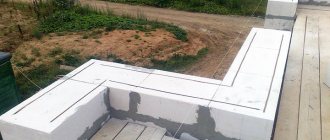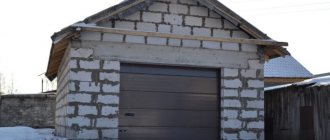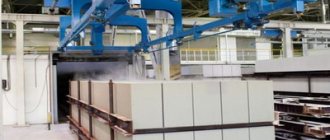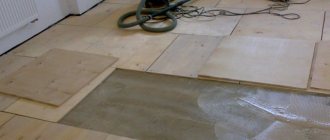The construction of houses from gas silicate blocks has recently gained particular popularity. This attention to the material is due to its unique technological characteristics. Today, gas silicate brick is used in the construction of houses and utility buildings, for the construction of fences and fences in industry. Gas silicate walls are light in weight and width and do not have a big impact on the foundation.
Technological characteristics of gas silicate blocks
The building material has its own characteristics that should be taken into account when using it in work:
- load on the foundation. Gas silicate material is much lighter than classic brick, but also much heavier than a frame structure or a house made of timber. That is why experts recommend reinforcing the masonry to distribute the load;
- block size. With the help of this building material, you can build a durable structure, but, like any other masonry, it needs an extremely strong foundation. Only the foundation can protect gas silicate walls from destruction that can be caused by soil movement;
- ability to accumulate moisture. To prevent gas silicate materials from “pulling” moisture, the foundation should be placed more than 50 cm from the ground. Experts also recommend using special waterproofing materials.
Gas silicate material is very sensitive to subsidence and deformation. Even slight vibrations in the ground can cause cracks to appear. That is why it is strictly forbidden to use a base made of an I-beam or channel when laying. It is also not recommended to use it for the construction of a basement. Reinforced concrete or brick, on which gas silicate masonry can already be installed, is suitable for these purposes.
Foundation for a gas silicate house
But like any other it has its drawbacks:
insufficient waterproofing; poor resistance to deforming loads. In this regard, it is worth choosing the foundation for a house made of gas silicate blocks in Moscow and the Moscow region very carefully in order to select the best option for a specific building, taking into account the nuances
According to their characteristics, bases are divided into four types and each of them has its own advantages and disadvantages. Taking into account the design features of gas silicate, we will consider each option.
Slab - this base is the most durable and stable option. It has a wide area, distributes the load evenly and minimizes deformation loads, preventing the appearance of cracks. It is a universal base on most soils and can withstand various climatic conditions and ground fluctuations. The main disadvantage is the high cost of its installation.
Tape - adjusting the depth level of this type of base allows you to adapt it to various designs and purposes. A strip foundation for a house made of gas silicate blocks is also in great demand due to its high stability indicators and is suitable for various geodetic indicators. Its strength and additional waterproofing during installation guarantee the integrity of the entire structure.
Pile - screw or bored piles are installed during the construction of a house with a maximum of two floors. To distribute the load and avoid cracks, a monolithic grillage is installed on top of the piles. They are used on unstable and problematic soils, thanks to the depth of penetration to stable rocks. It has a number of specific nuances during the installation process that affect its cost.
A columnar foundation for a gas silicate house is indispensable if there are rocky areas of soil at the building site. The pillars are installed in places with maximum load under the building; to distribute it over the entire building area, a monolithic grillage is also poured. To determine the depth of immersion, accurate calculations and the results of a geodetic inspection of the site are required.
When choosing a foundation for a house made of gas silicate blocks, many factors are taken into account and an inexperienced person can make mistakes in calculations and construction. This can lead to irreversible consequences.
We install any foundation for a gas silicate house in Moscow and the Moscow region. We employ professional designers and builders. We apply an individual approach and modern methods to each project. Our builders use the best systems in their work. materials and precise spec. technique. This ensures optimal results and compliance with all deadlines. Our specialists can answer all questions over the phone free of charge.
Cooperation with our company provides a number of advantages:
- free visit of a specialist to the construction site to assess the level of complexity of the work;
- individual approach taking into account all the client’s needs; quality work;
- timely delivery of the completed project on a turnkey basis;
- fix price;
- signing a contract with all points of the order included in it.
Requirements for foundations for gas silicate masonry
According to the regulatory requirements of the construction industry, the foundation for a gas silicate house can be designed in different ways. When choosing the type of base, you must consider:
- on what soil the building will be constructed. For example, on unstable soil, the ideal option is a foundation made of screw piles; therefore, the strip, columnar and slab foundation will gradually sag, negatively affecting the condition of the walls;
- flow of underground rivers. If groundwater passes too close to the surface, then preference should be given to the same screw piles. For those soils whose groundwater is deep, any type of foundation is suitable;
- location of the site. If construction is planned on a site with uneven terrain and differences of more than 1 m, it is recommended to use pile grillages.
When creating design documentation for the construction of a summer house from gas silicate blocks, calculations of several foundation options are used. The owner of the site can choose the type of foundation independently from the variations offered to him. As practice shows, budget plays an important role when choosing.
What foundations are suitable for a gas silicate house?
In the standards SP 22.13330, foundations are considered as a single structure with foundations (soils) located underneath them. When choosing which existing foundation is best suited for a block house, the following factors must be taken into account:
- calculated soil resistance - even with 2-3 times the load-bearing capacity reserve, strip, slab and columnar foundations will annually settle on peat, silty sand or fresh embankment that has not had time to self-compact. But screw piles will pass through unstable horizons and will rest on a layer with a high bearing capacity;
- groundwater level (GWL) – for high groundwater levels, a floating slab or screw piles are recommended; for low groundwater levels, any structures are allowed;
- terrain of the site - for height differences of more than 1 m, only pile grillages are used.
Attention! An important factor when designing a home is the construction budget. Therefore, an estimate for a gas silicate cottage is calculated for several types of foundations that provide maximum resource under existing geological and geophysical conditions. Then the cheapest one is selected from these options, taking into account the prices of building materials in the region.
floating slab
Traditionally, the most reliable foundation is a floating slab. When choosing this design, it is enough to take into account its main characteristics:
- budget – maximum, due to the high consumption of concrete and reinforcement;
- labor costs are low, the fertile layer is removed, four low panels are enough for formwork, reinforcement mesh is convenient to knit in place, concreting usually occurs in one step;
- contraindications – height difference of more than 1 m, fresh embankment, peat bog, dusty sand;
- disadvantages - the absence of a base part, is corrected by choosing a bowl-shaped slab, the stiffening ribs of which are directed upward.
The slab foundation is guaranteed to support the weight of a three-story block house. It can be erected in areas with high groundwater level and heaving soils.
Advice! The construction budget can be reduced by choosing an inverted bowl or an insulated Swedish USHP plate. In the first case, the thickness of the monolithic structure is reduced; in the second option, the developer receives a heated floor by default.
Monolithic grillage on pillars
If, according to the results of geological surveys, rocky, coarse sand or gravelly soil is identified in the building area and the groundwater level is below 2 m, the relief is flat, a monolithic grillage at the tops of pillars will cost the least. This block house foundation has the following characteristics:
- budget – average, professional calculation of bearing capacity is required;
- labor costs are average, you will need to dig holes for each pillar or trench under load-bearing walls, the consumption of lumber for formwork is high, but boards and plywood can be used in the future (partitions, rafters, sheathing);
- contraindications – soils with low design resistance, high groundwater, clay soil, complex terrain with slopes.
- disadvantages - a columnar foundation will only support the weight of a one-story building, lateral movements due to heaving threaten to overturn the structure.
Important! When choosing a columnar foundation, a hanging grillage is recommended to raise the gas silicate masonry above the ground.
Strip foundation
Despite the identical design of strip foundations, the laying depth varies from 0 to 2.5 m. This inevitably affects the construction budget, labor costs and delivery time of the facility. The choice of strip foundation is carried out as follows:
- rock, gravelly soil, coarse sand – unburied strip;
- sandy loam, medium sand, loam – MZLF with measures to eliminate swelling;
- the need for a basement floor is a deep tape, no options.
Using a strip foundation
The strip type base is ideal for the construction of a one-story building. When installing such a foundation, it is imperative to use additional materials with thermal insulation and waterproofing properties. The foundation for a house made of gas silicate blocks must be additionally protected from moisture.
When installing a foundation that is not too deep, pouring the slab may not be necessary. To carry out construction work, it is necessary to dig a trench around the perimeter with a depth of up to 0.5 m. A sand cushion should be laid at the bottom of the “pit”, the height of which will be at least 0.4 m. Next, the installation of wooden formwork, laying of the reinforcing belt and, in fact, pouring are carried out concrete foundation. Recessed strip-type foundations are used for the construction of multi-story buildings. It is also worth resorting to this technology if you are planning to build a summer house with a basement. Such a foundation needs a strong reinforcing belt. Create the foundation for a gas silicate house in the warm season. Pouring the foundation in winter is strictly prohibited.
What type of base is better to choose?
Depending on the number of storeys and geological conditions, the following options are suitable for the foundation of a house made of gas silicate blocks:
| Base type | Acceptable conditions, in which cases you need to choose | Requirements and recommendations |
| Shallow strip foundation | Suitable for one-story houses on stable and moderately stable soils | In addition to enhanced waterproofing along the perimeter of the building, a blind area is required |
| The same, deep | For heaving soils and buildings with basements | The laying is carried out at least 30 cm below the freezing level; it is better to choose a different building material for the walls of the cellar |
| Monolithic slab | For all types of soil except peat bogs and fine dust sand. Not suitable for height differences between extreme walls of more than 1 m | Elimination of such a disadvantage as the absence of a base part is solved by laying a bowl-shaped slab with stiffening ribs directed upwards |
| Columnar with monolithic grillage | Allowed exclusively on flat areas, low-moving (rocky, gravel) soils and one-story buildings. The choice of this type of foundation implies the absence of a cellar | To raise masonry made of gas silicate blocks above the ground level, a hanging grillage is required. It is recommended to fill the space between the pillars with crushed stone or close it |
| Pile-screw foundation | Suitable for all types of soil, optimal for construction on a slope | Design of a fence (underground protection) and insulation of communications are mandatory; a hanging grillage needs support |
Application of a monolithic base
With the help of a monolithic foundation, the load coming from the walls is distributed evenly. This base option can be used on any soil. With high-quality reinforcement, slab foundations can be used for multi-story apartment buildings. To build a summer house, you can use a monolithic base with a less strong reinforcing belt. But, it is worth remembering that such construction is more expensive than installing a strip foundation. The non-buried construction method is perfect for building a summer house. A monolithic foundation for a house is ideal for silicate masonry on unstable and very wet soils.
Recessed strip foundation for aerated concrete
A buried strip is a foundation installed below the soil freezing depth, which can range from 100 to 250 cm.
This type of foundation is very expensive in terms of concrete consumption. This choice is justified only if a basement floor is required.
Let's calculate how much concrete is required for the foundation strip of a 10x10 meter house with a thickness of 40 cm and a strip height of 200 cm.
Features of columnar bases
A columnar foundation can be used for the construction of light buildings from blocks. This base consists of a columnar frame. When installing the base, the pillars are installed in those places where the load on the foundation is greatest. For example, pillars should be installed in the corners of the future building. A grillage is mounted between the pillars, which is the connecting link. A columnar foundation is not used on uneven terrain and unstable soils. It cannot be used for the construction of structures made of gas silicate blocks, since this is a particularly fragile material that reacts to any soil movements.
Pros and cons of using gas silicate blocks
In order to understand the advantages and disadvantages of this building material, it is worth understanding the technology of its production. The production of the substance for the formation of blocks occurs in stages:
- preparing the mixture and performing gas generation. During this period, the mixture should rise several times. It is during gas formation that pores appear;
- frozen layers are cut into blocks. To perform this work, strings are used. The layers are cut into even blocks, which are dried in a special autoclave.
After production, a crystalline base of the building material is formed.
Thanks to its unique manufacturing technology, aerated concrete has many positive aspects, including:
- light weight;
- high coefficient of thermal insulation, sound insulation;
- resistance to sub-zero temperatures;
- environmental cleanliness;
- fire resistance.
Builders consider the disadvantages of this building material to be low strength and the ability to absorb moisture. But nevertheless, the construction of buildings, especially dachas and country houses, is growing rapidly. Gas silicate blocks are widely used in private construction. In addition, real craftsmen build a foundation from gas silicate material, creating it in accordance with the standards and requirements.
Installation of a foundation made of gas silicate blocks
As is known, a gas silicate block is easily deformed. But nevertheless, it is used to build the foundation for a country house. When performing this type of construction work, it is worth remembering that such a foundation needs very high-quality waterproofing. Today on the market you can purchase special mastics that can saturate porous material and prevent moisture from entering it. The main disadvantage of such impregnation is its rather high cost, and other mastics are simply not suitable. This is why gas silicate foundations are built very rarely.
0 0 vote
Article rating











